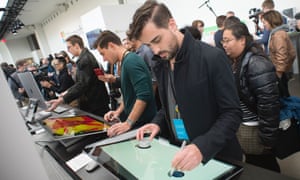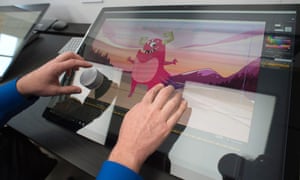
Microsoft is getting artsy. The tech giant unveiled tools for artists and designers on Tuesday in Manhattan, including a smartphone app that allows users to scan 3D images of everyday objects and move them around in virtual or “mixed” reality.
Satya Nadella, Microsoft’s CEO, said he anticipated a greater market for creative tools as the market for video display devices matures. “Much of technology has been slanted toward consumption,” Nadella said. “I believe that the next 25 years will be defined by technology that enables profound creation.”
The company demonstrated its new $3,000 Surface Studio computer, a desktop machine marketed to professionals with a huge touchscreen that works with Microsoft’s Surface Pen stylus. Ben Wolstenholme, a cartoonist who works with the digital publisher Madefire, told the Guardian he enjoyed the level of precision the screen allowed, and that the other hardware kept down lag time.
“I’ve had moments where I’m still using pen and ink and paper, but I’ve moved into a digital workflow,” Wolstenholme said. “I actually feel like I’m getting the range of mark I want. It really is fun.” Wolstenholme admitted that there were some aspects of the old fashioned ink-and-paper cartooning process that computers couldn’t recreate – notably, the mistakes. “One thing I miss is consequence,” he said. “You can control-Z anything.”
The Studio’s main hardware innovation is a small silver cylinder – a volume knob, essentially – that sits on the screen and can be used to fine-tune elements such as color tone on a drawing.

Surface Studios were displayed around the room with high-end games like the shoot-em-up title Gears of War and the racing game Forza Horizon 3 playing at higher levels of resolution than even the company’s dedicated gaming platform, the Xbox, can handle. The Studio will ship with Core i5 or Core i7 quad-core processors and up to 32 gigabytes of Ram, as well as a 2.1 surround sound system. Pricier versions range up to $4,100.
“I’m inspired by what I see in the Minecraft generation,” Nadella said.
The beginning of the presentation was devoted to Paint 3D, an update to Microsoft’s age-old Paint program released earlier this month, which allows artists to tweak digital objects in three dimensions. With a smartphone app, a user can render an object from the real world on the computer, change its colors or add elements to it, and then move it back into position in a half-real, half-digital world using Microsoft’s Hololens headset. Microsoft’s Megan Saunders demonstrated the technique with a sandcastle.
Windows, with Hololens, can be used to project video on to the walls of a room. The device’s software maps out real-world surfaces and allows the user to move objects around them; those objects can now come straight from a “window” on a wall where the operating system is displayed.
[Source:-The Guardian]



